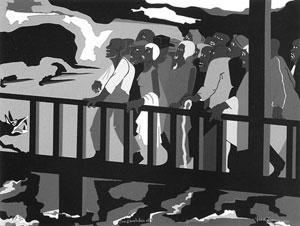 |
|
||
|
|||
![]()
BU Art Gallery exhibition
Jacob Lawrence’s art chronicles struggle and hope of people confronting oppression
By Brian Fitzgerald
|
|
|
|
Confrontation on the Bridge, 1975, silk screen, 19 1/2”x 25 7/8” Copyright Gwendolyn Knight Lawrence, courtesy of a private collection |
|
Visitors to the Jacob Lawrence exhibition at the BU Art Gallery will witness history through the eyes of one of the greatest artists of the Harlem Renaissance, whose work depicts critical moments in the 19th and 20th centuries.
They’ll also experience history firsthand, as the exhibition, Jacob Lawrence: Chronicles of Struggle and Hope, which runs through October 24, is the first show of Lawrence’s work in Boston to emphasize his print production years, from 1963 to 2000.
Lawrence was seen by many critics as the greatest African-American figure painter of his day. In the 1930s, after attending classes at the Harlem Community Art Center and the Harlem Artists Guild, he developed a style that CAS Art History Professor Patricia Hills calls “expressive cubism.” He went on to win numerous awards, including the National Medal for the Arts. He was still painting weeks before his death in 2000, at age 83.
|
|
Olympic Games, 1971, silk screen, 34 3/8”x 25 3/8” Copyright Gwendolyn Knight Lawrence, courtesy of the D.C. Moore Gallery, New York |
|
His style is distinguished by its bright colors and richly patterned compositions. “The colors are just dazzling,” says Hills, the exhibition curator. Lawrence’s debt to Henri Matisse — who employed pure color, simple shapes, and overlaps of form — is obvious, she says. His painting The Life of Harriet Tubman, No. 4, with its slave children skipping around a circle, bears more than a passing resemblance to Matisse’s 1909 painting The Dance. However, “Matisse often used very fluid lines,” according to Hills, “whereas in Jacob Lawrence’s work there are disjunctions — jarring juxtapositions that give his works a little bit of tension, a dynamic quality. Matisse is definitely in the background in Lawrence’s creative process, but he was also influenced by the art of Mexican muralists Diego Rivera and Jose Orosco, as well as Francisco Goya and George Grosz — all people who dealt with class struggle and people overcoming adversity.”
Indeed, the socially conscious artist used controversial historical figures as subjects, and works on display at the BU Art Gallery include paintings, drawings, and prints of Toussaint L’Ouverture, one of the leaders of the Haitian slave revolt of 1791, abolitionist John Brown, who was hanged after he led a raid on the federal armory at Harpers Ferry, Va., in 1859, and of course, Harriet Tubman.
A highlight of the exhibition documents another pivotal event: the 1945 atomic bomb explosion over Hiroshima. A group of eight gouache paintings, created to accompany the 1983 deluxe edition of John Hersey’s 1946 book Hiroshima, presents a visual interpretation of the moments following the blast. “Limited Editions Club of New York asked him to illustrate a book of his choosing, and he picked Hiroshima, which is a very chilling book,” Hills says. “ Lawrence’s paintings give you a sense of what happened.” The series depicts the effects of the bomb on people in eight settings: a marketplace, a playground, a street scene, a park, farmers in a field, a family scene, a man feeding birds, and a boy flying a kite.
|
|
General Toussaint L’Ouverture, 1986, silk screen, 28 3/8”x 18 1/2” Copyright Gwendolyn Knight Lawrence, courtesy of the D.C. Moore Gallery, New York |
|
Lawrence wrote that he selected Hiroshima “because of its power, insight, scope, and sensitivity, as well as for its overall content.” He insisted that the paintings weren’t meant to be illustrations for the text. “I wanted it to be in terms of man’s inhumanity to man — a universal kind of statement.” The subjects in the paintings have skulls for heads and blood-red hands. “You get the sense of the flesh dropping off of people,” says Hills.
“Is it not ironic,” wrote Lawrence, “that we have produced great scientists, great musicians, great orators, chess players, philosophers, poets, and great teachers and at the same time, we have developed the capability and the genius to create the means to devastate and to completely destroy our planet earth with all its life and beauty? How could we develop such creative minds and at the same time develop such a destructive instrument? Only God knows the answer. Let us hope that some day at some time He will give us the answer to this very perplexing question.”
On Friday, October 1, from 6 p.m. to 8 p.m. at the BU Art Gallery, Hills will participate in the panel discussion On Jacob Lawrence, Langston Hughes, Alain Locke, and the Harlem Renaissance, with Jeffrey Stewart, a professor of history and art history at George Mason University, and Martha Nadell, an assistant professor of English at Brooklyn College. On Wednesday, October 13, at 1 p.m., Michelle DuBois, coauthor of Jacob Lawrence: Paintings, Drawings and Murals (1935-1999), A Catalogue Raisonné, will talk about Lawrence’s life and work. For gallery hours, visit www.bu.edu/art.
![]()
10
September 2004
Boston University
Office of University Relations


